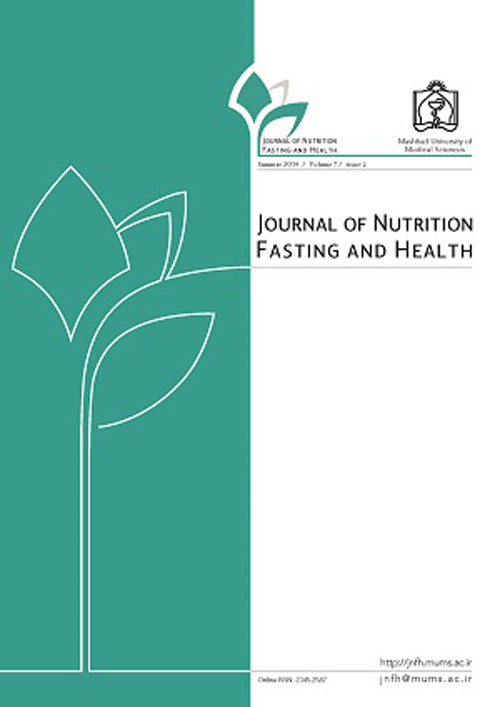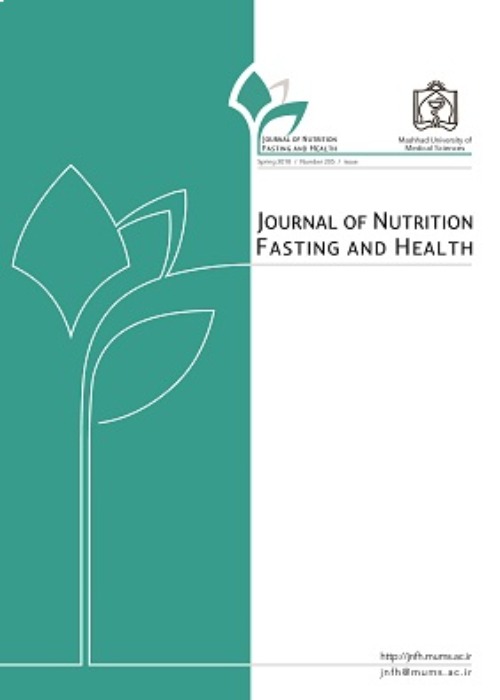فهرست مطالب

Journal of Nutrition, Fasting and Health
Volume:7 Issue: 3, Summer 2019
- تاریخ انتشار: 1398/05/02
- تعداد عناوین: 8
-
-
Pages 116-120Ramadan is the Holy month of fasting that is obligatory for all normal Muslims who reached at their puberty. Two meals are taken during Ramadan, one is taken before down to prepare themselves for fast is called “Sahur”, and second meal is taken at sunset is called “Iftar”. Fasting is not only a ritual and religious obligation while it has several medicinal significances specially against diet dependent diseases. Fasting significantly helped in the reduction of peptic and duodenal ulcers with the combination of H2-blocker drug, help in the improvement of lipid profile specially in TC and HDL and LDL levels that cause heart failure. During fasting the systolic and diastolic blood pressure improve at greater rate as compare to drugs like Indapamide and Perindopril, a strong evidence revealed that ischemic stroke and cancer can also be improved by intermitted fasting through multiple pathways and factors like BDNF, bFGF, GRP78, Hsp70, tyrosine kinase receptor B (TrkB), fibroblast growth factor receptor 1 (FGFR1), and ketosis respectively The aim of this paper is to systematically review the published literature regarding the effect of Ramadan on the above mentioned diseases.Keywords: Ramadan, fasting, Iftar, Ischemic stroke, ketosis
-
Pages 121-129IntroductionIrritable bowel syndrome (IBS) is the most common functional gastrointestinal disorder, which is characterized by the presence of abdominal pain or discomfort associated with altered bowel habits. This systematic review aimed to assess the nutritional factors (dietary patterns and food groups) associated with IBS.MethodsArticles were collected via searching in databases such as Medline, EMBASE, CINAHL, ProQuest, PubMed, Scopus, ScienceDirect, and Google Scholar using relevant keywords and phrases, including irritable bowel syndrome, pattern, intake, behavior, habit, meal, nutrition, food, lifestyle, and prevalence. The articles were confined to the original human studies that were published in English since 2010. Duplicates and unrelated materials were excluded.ResultsConsumption of processed meat, fast foods, and legumes has been reported to increase the risk of IBS. However, the correlation between the consumption of milk, fruits, and vegetables has not been conclusive. Moreover, the association between cereal intake and risk of IBS varies depending on the type of cereals. The results also indicated that fast food dietary patterns increased the risk of IBS, while lacto-vegetarian dietary patterns reduced the risk of IBS.ConclusionAccording to the results, the effects of some food groups on IBS are unclear. In addition, research in this regard is limited to food patterns, and further investigations are required in order to reach conclusive results.Keywords: Dietary patterns, Food groups, Irritable Bowel Syndrome
-
Pages 130-137IntroductionDiabetes is a metabolic disease, which is directly correlated with increased physical disabilities and muscle tissue damage. The present study aimed to investigate the anti-apoptotic effects of interval and continued training and crocin on diabetic rats.MethodsIn this study, 49 adult rats aged eight weeks with diabetes inducaed by a high-fat diet and venous injection of streptozotocin were randomly assigned to seven groups, including high-intensity interval training (HIIT), low-intensity continued training (LICT), HIIT with crocin consumption, LICT with crocin consumption, crocin consumption, sham, and control. The animals in the HIIT and LICT groups ran on a treadmill three sessions per week for eight weeks at the intensity of 80-85% and 50-55% of the maximum speed, respectively. The animals in the crocin consumption groups received 25 mg/kg of crocin weekly for eight weeks.ResultsHIIT and LICT could significantly increase Bcl-2 and decrease Bax and p53, as well as the ratio of Bax and Bcl-2 (P≤0.05). In addition, crocin consumption could significantly increase Bcl-2 and decrease Bax (P≤0.05). Training with crocin consumption had interactive effects on the increase of Bcl-2 and decrease of p53 and ratio of Bax to Bcl-2 (P≤0.05).ConclusionAccording to the results, continued and interval training along with the consumption of crocin exerted interactive anti-apoptotic effects on the rats with diabetes induced by a high- fat diet.Keywords: Interval training, Continued Training, Crocin, Apoptosis, Diabetes
-
Pages 138-145IntroductionThe demand for antimicrobial compound alternatives to replace synthetic additives is on the rise. In food commodities, use of synthetic antimicrobials based on herbal extracts is attracted attention. The present study aimed to assess the chemical, microbiological, and sensory properties of the yogurt samples treated with oregano extract (0%, 0.75%, 1%, and 1.5%) during storage for 30 days at refrigerated temperature.MethodsThe in-vitro antibacterial effect of oregano extract was evaluated using agar disk-diffusion assay. Natural yogurt was prepared using a combination mixture of whole milk and 4% skimmed milk powder. Various concentrations of the oregano extract (0%, 0.75%, 1%, and 1.5%) were added to the samples. During 30 days of refrigerated storage, various parameters were evaluated, including titratable acidity, pH, mold and yeast counts, total coliforms, and sensory attributes (overall liking, appearance, and aroma).ResultsThe descending order of the in-vitro antibacterial effect of the oregano extract was as follows: Listeria monocytogenes>Staphylococcus aureus>Bacillus subtilis>Bacillus cereus>Salmonella typhimurium>Escherichia coli O157:H7. Differences were observed in the counts of mold and yeast in the samples over time. Accordingly, bioactive yogurt had lower mold and yeast counts (1-1.5 log CFU/g) after 30 days of storage compared to the control (P<0.05). In addition, significant differences were observed in the hedonic scores of aroma and appearance between the samples containing the oregano extract compared to the control group (P<0.05).ConclusionAccording to the results, oregano extract could be used as a natural compound to improve the shelf life of yogurt at refrigerated temperatures for 30 days. Furthermore, oregano extract is considered to be an effective inhibitory compound against L. monocytogenes, S. aureus, B. subtilis, B. cereus, S. typhimurium, and E. coli O157:H7.Keywords: Oregano extract, Yogurt, Shelf life
-
Pages 146-150IntroductionNon-alcoholic fatty liver disease (NAFLD) is considered to be a severe health threat across the world, the prevalence of which has significantly increased in recent years. Considering the role of diet in the pathogenesis of NAFLD, the present study aimed to evaluate and compare the dietary intakes of patients with NAFLD with healthy subjects.MethodsThis case-control study was conducted on 120 participants aged more than 18 years. The case group included 60 patients who were diagnosed with NAFLD based on Fibroscan assessment. The diet records of the subjects were analyzed using a three-day dietary record questionnaire.ResultsAfter modulation based on energy intake, the total intakes of energy, fiber, vitamin D, and vitamin E were significantly lower in the patients with NAFLD compared to the control group. In addition, the level of trans-fatty acids after energy adjustment was significantly higher in NAFLD patients compared to the controls. However, analysis after the energy adjustment indicated no significant difference between the case and control groups in terms of protein, carbohydrate, saturated fatty acid, monounsaturated fatty acid, and polyunsaturated fatty acid intakes.ConclusionAccording to the results, the diet records of the patients with NAFLD and healthy subjects differed in terms of the intakes of energy, fiber, trans-fatty acids, vitamin D, and vitamin E. Therefore, special attention must be paid to the dietary patterns of these individuals in order to improve their lifestyle and prevent the occurrence and progression of NAFLD.Keywords: Non-alcoholic fatty liver disease, Diet record, FibroScan
-
Pages 151-159IntroductionDietary diversity score (DDS) and Food variety score (FVS) are the appropriate measures used to evaluate the overall quality of dietary patterns. However, their associations with the serum levels of micronutrients remain unclear. The present study aimed to investigate the correlations between DDS/FVS and serum ferritin and magnesium status in the non-athlete females joining the sports clubs in Tehran, Iran.MethodsThis cross-sectional survey was conducted on 397 non-athlete women, who were members of the sports clubs in Tehran, Iran in 2013. Dietary intake was assessed using a 24-hour recall questionnaire. DDS and FVS were calculated and classified into two groups based on the guidelines of the minimum dietary diversity of women (MDD-W) and median, respectively. Serum ferritin was measured using the ELISA assay, and serum magnesium was measured using atomic absorption spectrophotometry.ResultsMean DDS and FVS was 5.7±1.4 (range: 2-9) and 15.3±4.7 (range: 5-32), respectively. After adjustment for the confounding factors, serum magnesium in the group with high FVS was significantly higher compared to the other group (P=0.01). In the group with high FVS, serum ferritin was also higher, and the difference was considered significant (P=0.058). In addition, linear regression analysis indicated a significant association between high FVS and serum magnesium level (P=0.02). However, no significant correlations were observed between the serum levels of micronutrients and DDS.ConclusionAccording to the results, higher FVS may be associated with higher serum magnesium and ferritin levels. Further investigations are required to assess the correlations between DDS, FVS, and the status of serum micronutrients.Keywords: Dietary Diversity, Food Variety, Ferritin, magnesium, Micronutrient
-
Pages 160-167IntroductionMuscular inflammation and atrophy is one of the characteristics of diabetes that causes motor disability in these individuals. Studies have shown that exercise training with different intensities and the use of herbal drugs can have favorable effects on diabetes. The aim of this study was to interactive effects of continuous and interval training with crocin consumption on interleukin 17 and 18 in the Soleus Muscle of type 2 Diabetic Rats.MethodsIn this experimental study, 49 adult diabetic rats were randomly assigned to seven groups, including: high intensity interval training (HIIT), low intensity continuous training (LICT), HIIT + crocin consumption, LICT + crocin consumption, crocin consumption, sham, and control. HIIT and LICT groups did training for eight weeks on rodent treadmill, respectively. Crocin groups received 25 mg/kg of daily crocin for 8 weeks peritoneally. The gene expression levels of the variables were measured using Real Time-PCR.ResultsHIIT increased IL-17 and 18 in the Soleus muscle tissue (p≤0.05), but LICT does not have a significant effect on changes in IL-17 and IL-18 (p≥0.05). Crocin consumption decreased expression of IL-18 and increased IL-17 in the Soleus muscle tissue (p≤0.05), and interaction of LICT and crocin consumption was significant in increasing IL-17 and IL-18 (P≤0.05).ConclusionHIIT seems to have inflammatory effects in the muscle tissue of type 2 diabetic rats. However, the interaction of LICT and crocin was significant in the increase of IL-17 and IL-18 in the Soleus muscle tissue of type 2 diabetes rats.Keywords: Training, Crocin, IL-17, IL18, Diabete
-
Pages 170-174Introduction
The Ethiopian Orthodox Lenten fasting (Abbiy Tsom), is the period of 8-weeks of fasting before Easter. It is one of religious fasting less documented in the scientific literature. Thus, the aim of this study was to compare the different variables during Lenten fasting versus after Lenten fasting in anthropometric and body composition parameters.
MethodsNinety-eight subjects (40 females and 58 males) aged between 18 and 40 years, who indicated their intention to fast Lenten for 8-weeks participated in the study. Body weight, height, waist and hip circumferences were measured, body mass index (BMI) and waist-to-hip ratio (WHR) were calculated. Percent body fat (%BF) was determined by using a skin fold thickness at 3-sites (abdomen, triceps, and suprailiac) by using a caliper (Haldan Ltd. UK).
ResultsWeight, BMI, %BF, and FM were lower significantly (p< 0.05) at the end of 8-weeks of Lenten compared with 8-weeks after Lenten, with men experiencing a greater percent decrease as compared to women.
ConclusionLenten diet adherence (vegan diet) compared with regular mixed diet intake resulted in lower anthropometric and body composition, which may potentially be linked to improved cardio-metabolic health.
Keywords: Body composition, fasting, Diet-, Lenten Vegetation


